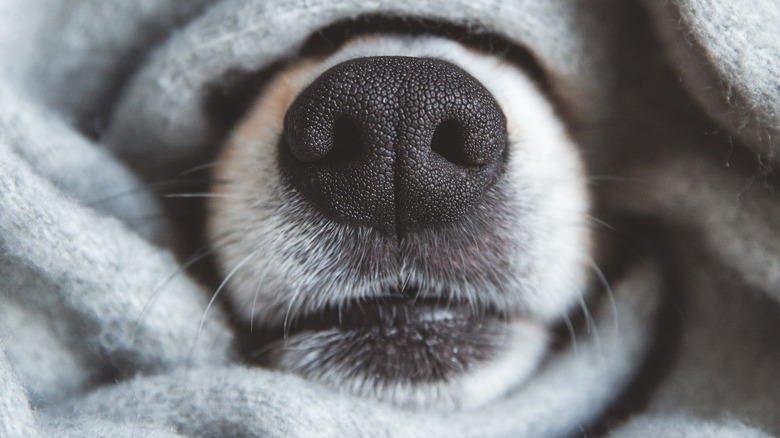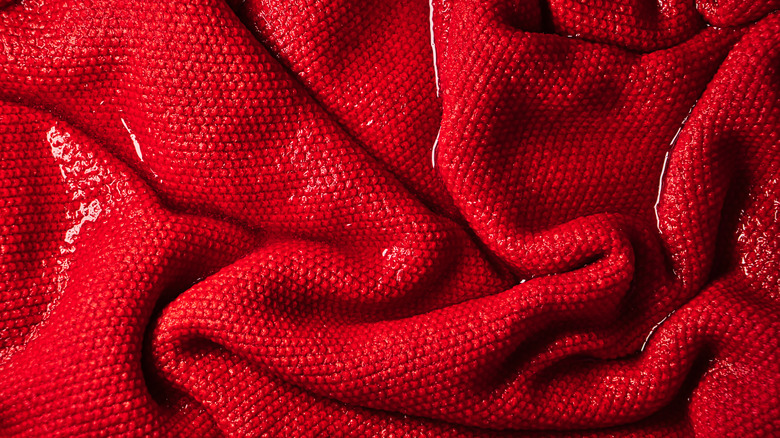The Best Way To Wash A Wool Blanket
Humans have used wool to stay warm and cozy for thousands of years. According to Lands' End, the fibrous structure has many tiny air pockets, which both hold and circulate heat. This breathable insulation makes it the perfect material for blankets.
There's more than just temperature and breathability to commend about a woolen blanket. Because this material is made of natural fibers, it is both hypoallergenic and odor-repellant, according to Woolmark. As well as being lightweight, crease-resistant and soft, wool blankets have a lot going for them.
However, stressful moments come when it's time to wash a wool blanket — chances are, you or someone in your family has begun to develop some strong positive feelings for this thing! And if washed the wrong way, it can shrink a lot and lose its texture. As Harvard's Science in the News explained, the fibers that create wool's tiny air pockets are sort of shaped like springs, and if they get too wet, hot, and agitated, they fill with water and twist into one another. This compacts the wool into felt and shrinks the garment or blanket in question.
So, how can you avoid this and get your blanket clean? Keep reading to find out.
How to properly wash your wool blanket
Firstly, check the label to see if your blanket is not "dry-cleaning only." There have been great advances in fiber treatments that make it possible to wash a lot of woolen blankets at home, but if the label says not to, trying to cleanse it yourself will probably go badly, so leave it to the dry cleaners.
Now, prepare a cool bath for the blanket. If you have a top-loading washing machine, use that, with the settings on the coldest possible. If you don't have a top loader, a bath or sink will perform better than a front load machine. According to The Wool Company, the bath should be less than 85°F and mixed with an appropriate amount of wool-safe detergent. Soak the blanket in the bath and move around to ensure all air bubbles are released, so the material will stay submerged as it soaks. Leave for at least 30 minutes.
Rinse the blanket with a rinse cycle with minimum spin or cool, clean water. It is important to start drying the blanket as soon as the washing phase has finished. The British Blanket Company advised laying the wet material between two clean towels and rolling to gently tease the excess water out. Then, lay it flat, out of direct sunlight, to dry completely before using it again.
Take care of your wool blanket between washes
With all of the extra stress and hands-on steps, it's good news that needing to wash your wool blanket should be a rarity! Inevitably, accidents happen, but barring unfortunate circumstances, you can avoid needing to wash your wool blanket as often by caring for it as well as possible.
Some may recommend the traditional Irish "good drying day" — otherwise known as airing out the wool. This relies on the breathability of wool fibers and the traveling airflow to shake loose dirt and odors. Luvian Woollens agreed that ventilation is the best way to keep a wool blanket fresh. They also suggested using a soft bristle brush to both enhance the look of it as well as remove any dirt or lint that may have collected on the surface.
For more persistent marks that are still small enough to avoid having to clean the whole hog and immersion-wash the blanket, Atlantic Blankets suggests a sponge soaked in cool water with a mild detergent. Remember, spot cleaning still requires care throughout the cleaning, rinsing, and drying stages to avoid shrinking or stretching of the material.
It is best to clean your wool blanket before storing it, allowing it to dry completely before folding up and placing it inside a cotton bag that's kept somewhere cool and dark, Moth Prevention recommends. This way, no lingering organic material will attract moths, and sunlight won't bleach the colors.


